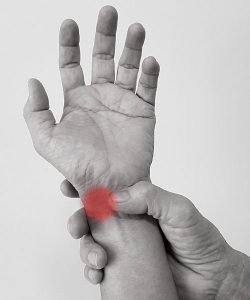
Common Wrist Injuries
As discovered in our previous blog, wrist injuries can often occur due to prolonged office work. Below are some common wrist injuries that can occur so we have given some insight into how they can present.
Wrist Repetitive Strain Injury
Repetitive strain injury (RSI) is an umbrella term used to describe the pain felt in muscles, joints and tendons caused by repetitive movement and overuse. It’s also known as work-related upper limb disorder, or non-specific upper limb pain. In office workers it mostly affects wrist joint and first two fingers and associated tendons. A specific diagnosis will depend on the structure being strained, tendinitis (i.e. affecting the tendon) being most common.
The symptoms of RSI can range from mild to severe and usually develop gradually. They often include pain, aching, tenderness, tightness, throbbing and weakness. At first, you might only notice symptoms when you’re carrying out a particular repetitive action. But without treatment, the symptoms of RSI may eventually become constant and cause longer periods of pain. You may also get swelling in the affected area, which can last for several months.
Carpal tunnel Syndrome
Carpal tunnel syndrome is caused by compression of the median nerve when it passes through the wrist. The median nerve carries the sense of touch to the thumb and most of the next 2 fingers, and controls movement for some of the hand muscles.
The most common symptoms of carpal tunnel syndrome include tingling or numbness in the thumb and next 2 fingers or the palm of your hand. It can also include nerve pain in your wrist or hand. This can shift up the arm or down to the fingers, hand weakness, or swollen fingers. Symptoms are usually worse in the dominant hand, but the condition can affect both hands.
Over time, people with carpal tunnel syndrome might find that they slowly lose strength and movement in their hand and wrist.
DeQuervains Tenosynovitis
De Quervain’s Tenosynovitis is a painful inflammation of tendons on the side of the wrist at the base of the thumb. The muscles associated with those tendons are located on the top side of the forearm and go to the base of the thumb. The nagging pain, sometimes sharp at the base of the thumbs, which is the main complaint, gets worse with the thumb movement. Additionally, with grasping and wrist movement. Thickening and swelling can also be present on the tendons over the side of the wrist.
If left untreated, the ongoing inflammation induces the structural changes in the tendons leading to the tendinopathy. Tendons become thicker, weaker, and more rigid, leading to progressively worsening pain.
Exacerbation of pre-existing Wrist conditions
Office work even though not being a direct cause can worsen other conditions affecting hand and wrist. These include osteo- and rheumatoid arthritis, gout, existing ganglion cysts (small enclosed collection of fluid inside a tendon or next to a joint), cervical nerve root impingements. Sustained positions and repetitive action are mainly to blame, however environmental factors, such as low temperatures from air conditioning, or lack of breaks and insufficient fluid intake can be at play.
Don’t be alarmed! We have seen a very high success rate of treating these conditions with conservative management.
Out physiotherapist utilises manual therapy, exercise and ergonomic adjustment of the workplace. Get in touch by calling 07 3352 5116 or book in online to see how we can keep your wrists conditioned and healthy.







